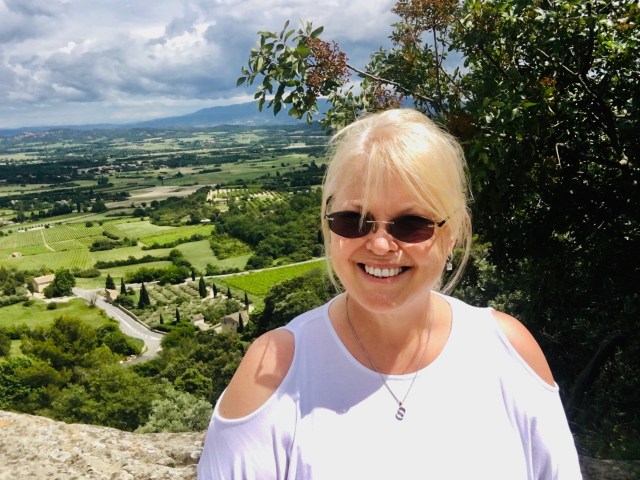In search of lavender.
Summer in Provence means lavender – fields and fields of breathtaking swathes of mauve flowers waving in the summer breeze to the seasonal music of Provence – cicadas (or ‘cigales’ as they’re known in France.)
Lavender flowers bloom in Provence during high summer – bursting into life anytime between June and August depending on weather conditions. Lavender is one of the major industries of the region – from these fragrant flowers is made oil, soaps and more.
The spectacle of the vast purple fields is a sight to behold, I’d been told but I’d only ever seen it pictures.
Alas, it was early in the season and we expected that our visit preceded the flowering so we’d set off mid morning with the sole intention of exploring the pretty villages of the Luberon instead – we should have stuck to our plan.
Gordes was the first stop and after a splendid lunch at the ancient hilltop village we stopped for a photo opportunity at a lookout on a rocky outcrop perched precariously high above the valley with no safety fence (together with half of the German and Japanese population). After this death-defying stunt, we started out for Roussillon – the village built out of, not 50 shades of grey, but 18 shades of ochre, mined nearby.

Then fate played her mischievous hand. There was that signpost!
“Sault 32kms,” it read.
Sault is the epicentre of lavender cultivation in Provence; all the photos I’d seen of lavender fields were in Sault.
“We should go to Sault'” I said to my companion.
“It’s not that far, only 32kms and maybe, with a bit of luck, some of the early-flowering lavender will be in bloom.
Famous last words!
My companion didn’t mind, a non-drinker, he had had an alcohol-free lunch and was up for the drive, whereas I had drunk two glasses of chilled rosé in typically Provençal fashion and was feeling relaxed.
As it turned out, both things were serendipitous.
Because, we began a terrifying journey over 32kms of narrow, winding, mountainous roads with terrifying drops that seemed to always be on the right (passenger’s side in France) and with a driver who had scant idea of where the edge of the car was in relation to the edge of the cliff (an alarming syndrome of those used to driving on the left of the road.)
Some hours later (or so it felt), we descended into the valley of Sault. You’d think the ‘valley’ part of the name would have alerted me to the mountains that needed to be crossed to get there, wouldn’t you? But no, I’d missed that obvious clue.
And there they were, the fields of lavender – and how GREEN was this valley?
Hardly a skerrick of purple to be seen, except, scattered sparsely here and there, on the edges of the fields were flowering purple plants – I like to think they were an early-flowering species of lavender, my companion scoffed: they were weeds. We’ve never really agreed on this.
What’s more, ominous black storm clouds had followed us into the valley. How were we going to get out of here – there was nothing surer than I wasn’t going back the way we came?

I know: I’d ask in the town centre for the flattest and widest road out of this darkly green valley.
“Pfftt,” said the owner of the bar, giving me that look of disdain that the French are so good at. Didn’t I understand that I was in the mountains? Flat roads “n’existent pas!”
So with only the GPS of the car to guide us and after making sure the route was a different one to the treacherous (and now storm-laden) route we came in on, we set off home – over Mont Ventoux! What were we thinking? Well we weren’t really – seeing the GPS had not forewarned us but had left us to find out about Mont Ventoux (and the crossing of it) by bitter experience.
Known as ‘The Beast of Provence’, Mont Ventoux is the highest peak in Provence at 1909 metres high. Halfway up, at about 1000 metres, we hit dense fog. The only saving grace was that now, I wasn’t able to see how perilously close to the edge my spatially-challenged companion was taking the car or how far the drop was – although the automatic sensors on the car were often ‘beeping’ hysterically.
There was still packed snow on the top of the mountain (remember, it was high summer) and what goes up, must come down. It was no picnic!
While I’ve lived to tell the tale, there is a moral to this story and words of caution for the reckless:
- Consult the topography of the region before you set out. Any name with ‘valley’ in the title is likely to be surrounded by mountains (ditto for ‘Port’ and water another clue I’d missed on another occasion.)
- You’ll find there is no need to cross the mountains to Sault to see lavender fields. The fields are not ALL in Sault. There are fields on the flat(ter) side of the Luberon – some very famous ones are not too far from Gordes.
- Call the Tourist Office before you make plans, they will know when the lavender is flowering.
- If you still intend to go to Sault, hire a driver familiar with the area and who is competent driving on the right.
And lastly, don’t ask me to come with you.


